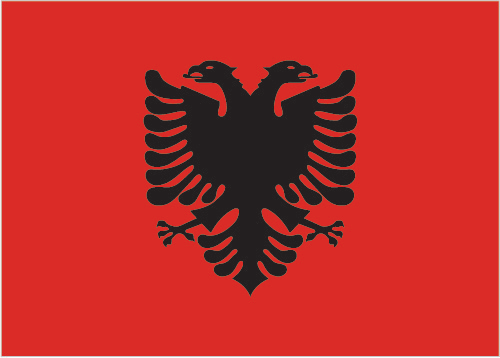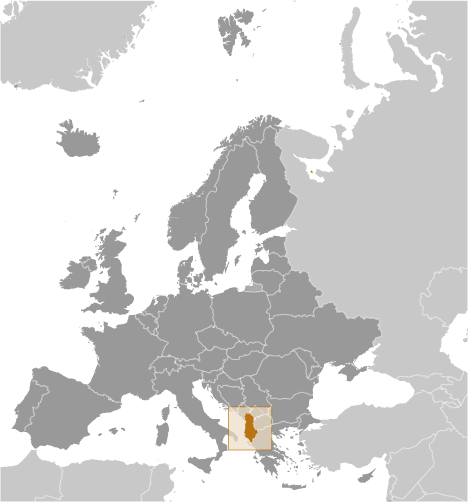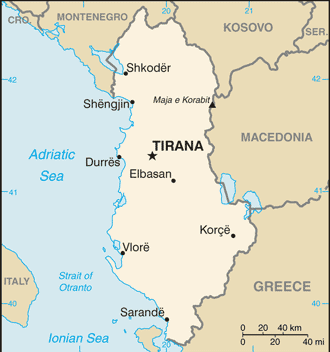|
Economy - overview:
|

|
|
Albania, a formerly closed, centrally-planned state, is making the difficult transition to a more modern open-market economy. Macroeconomic growth averaged around 6% between 2004-08, but declined to about 3% in 2009-11, and 0.5% in 2012. Inflation is low and stable. The government has taken measures to curb violent crime, and recently adopted a fiscal reform package aimed at reducing the large gray economy and attracting foreign investment. Remittances, a significant catalyst for economic growth declined from 12-15% of GDP before the 2008 financial crisis to 8% of GDP in 2010, mostly from Albanians residing in Greece and Italy. The agricultural sector, which accounts for almost half of employment but only about one-fifth of GDP, is limited primarily to small family operations and subsistence farming because of lack of modern equipment, unclear property rights, and the prevalence of small, inefficient plots of land. Energy shortages because of a reliance on hydropower - 98% of the electrical power produced in Albania - and antiquated and inadequate infrastructure contribute to Albania's poor business environment and lack of success in attracting new foreign investment needed to expand the country's export base. FDI is among the lowest in the region, but the government has embarked on an ambitious program to improve the business climate through fiscal and legislative reforms. The completion of a new thermal power plant near Vlore has helped diversify generation capacity, and plans to upgrade transmission lines between Albania and Montenegro and Kosovo would help relieve the energy shortages. Also, with help from EU funds, the government is taking steps to improve the poor national road and rail network, a long-standing barrier to sustained economic growth. The country will continue to face challenges from increasing public debt, having slightly exceeded its former statutory limit of 60% of GDP in 2012. Strong trade, remittance, and banking sector ties with Greece and Italy make Albania vulnerable to spillover effects of the global financial crisis.
|
|
|
GDP (purchasing power parity):
|

|
|
$25.86 billion (2012 est.)
country comparison to the world: 121
$25.73 billion (2011 est.)
$24.98 billion (2010 est.)
note:
data are in 2012 US dollars
Albania has an informal, and unreported, sector that may be as large as 50% of official GDP
|
|
|
GDP (official exchange rate):
|

|
|
$12.39 billion (2012 est.)
|
|
|
GDP - real growth rate:
|

|
|
0.5% (2012 est.)
country comparison to the world: 174
3% (2011 est.)
3.5% (2010 est.)
|
|
|
GDP - per capita (PPP):
|

|
|
$8,000 (2012 est.)
country comparison to the world: 130
$7,800 (2011 est.)
$7,500 (2010 est.)
note:
data are in 2012 US dollars
|
|
|
GDP - composition by sector:
|

|
|
agriculture: 20.4%
industry:
19.1%
services:
60.5% (2012 est.)
|
|
|
Labor force:
|

|
|
1.071 million (2011 est.)
country comparison to the world: 141
|
|
|
Labor force - by occupation:
|

|
|
agriculture: 47.8%
industry:
23%
services:
29.2% (September 2010 est.)
|
|
|
Unemployment rate:
|

|
|
13% (2012 est.)
country comparison to the world: 133
13.3% (2011 est.)
note:
these are official rates, but actual rates may exceed 30% due to preponderance of near-subsistence farming
|
|
|
Population below poverty line:
|

|
|
12.5% (2008 est.)
|
|
|
Household income or consumption by percentage share:
|

|
|
lowest 10%: 3.5%
highest 10%:
29% (2008)
|
|
|
Distribution of family income - Gini index:
|

|
|
34.5 (2008)
country comparison to the world: 89
26.7 (2005)
|
|
|
Investment (gross fixed):
|

|
|
25.8% of GDP (2012 est.)
country comparison to the world: 44
|
|
|
Budget:
|

|
|
revenues: $3.262 billion
expenditures:
$3.669 billion (2012 est.)
|
|
|
Taxes and other revenues:
|

|
|
26.3% of GDP (2012 est.)
country comparison to the world: 114
|
|
|
Budget surplus (+) or deficit (-):
|

|
|
-3.3% of GDP (2012 est.)
country comparison to the world: 118
|
|
|
Public debt:
|

|
|
60.6% of GDP (2012 est.)
country comparison to the world: 47
58.9% of GDP (2011 est.)
|
|
|
Inflation rate (consumer prices):
|

|
|
2% (2012 est.)
country comparison to the world: 33
3.5% (2011 est.)
|
|
|
Central bank discount rate:
|

|
|
5% (31 December 2010 est.)
country comparison to the world: 66
5.25% (31 December 2009 est.)
|
|
|
Commercial bank prime lending rate:
|

|
|
13.2% (31 December 2012 est.)
country comparison to the world: 67
12.43% (31 December 2011 est.)
|
|
|
Stock of narrow money:
|

|
|
$2.677 billion (31 December 2012 est.)
country comparison to the world: 119
$2.575 billion (31 December 2011 est.)
|
|
|
Stock of broad money:
|

|
|
$9.951 billion (31 December 2011 est.)
country comparison to the world: 107
$9.426 billion (31 December 2010 est.)
|
|
|
Stock of domestic credit:
|

|
|
$8.587 billion (31 December 2012 est.)
country comparison to the world: 107
$8.408 billion (31 December 2011 est.)
|
|
|
Market value of publicly traded shares:
|

|
|
$NA
|
|
|
Agriculture - products:
|

|
|
wheat, corn, potatoes, vegetables, fruits, sugar beets, grapes; meat, dairy products; sheep
|
|
|
Industries:
|

|
|
perfumes and cosmetic products, food and tobacco products; textiles and clothing; lumber, oil, cement, chemicals, mining, basic metals, hydropower
|
|
|
Industrial production growth rate:
|

|
|
3% (2010 est.)
country comparison to the world: 96
|
|
|
Current account balance:
|

|
|
-$1.45 billion (2012 est.)
country comparison to the world: 125
-$1.695 billion (2011 est.)
|
|
|
Exports:
|

|
|
$2.121 billion (2012 est.)
country comparison to the world: 142
$1.954 billion (2011 est.)
|
|
|
Exports - commodities:
|

|
|
textiles and footwear; asphalt, metals and metallic ores, crude oil; vegetables, fruits, tobacco
|
|
|
Exports - partners:
|

|
|
Italy 45.3%, China 7.8%, Turkey 6.3%, Greece 5.2%, Spain 5.1%, India 4.6% (2011)
|
|
|
Imports:
|

|
|
$5.219 billion (2012 est.)
country comparison to the world: 126
$5.076 billion (2011 est.)
|
|
|
Imports - commodities:
|

|
|
machinery and equipment, foodstuffs, textiles, chemicals
|
|
|
Imports - partners:
|

|
|
Italy 33%, Greece 12.2%, China 5.9%, Turkey 5.6%, Germany 4.3% (2011)
|
|
|
Reserves of foreign exchange and gold:
|

|
|
$2.35 billion (31 December 2012 est.)
country comparison to the world: 119
$2.473 billion (31 December 2011 est.)
|
|
|
Debt - external:
|

|
|
$5.281 billion (31 December 2012 est.)
country comparison to the world: 111
$5.188 billion (31 December 2011 est.)
|
|
|
Exchange rates:
|

|
|
leke (ALL) per US dollar -
103.3 (2012 est.)
100.9 (2011 est.)
103.94 (2010 est.)
94.98 (2009)
79.546 (2008)
|
|
|
Fiscal year:
|

|
|
calendar year
|
|
|
|





 )
)



